Exploring the Strengths and Limits of Strong and Weak Sustainability Indicators: A Case Study of the Assessment of China’s Megacities with EF and GPI
Abstract
:1. Introduction
2. Materials and Methods
2.1. Selection of Megacities
2.2. Selection of Indicators
2.3. Data Processing
3. Results
3.1. EF and BC
3.2. GPI and GDP
3.3. EF and GPI
4. Discussion
4.1. The Differences of Evaluation Processes between EF and GPI
4.2. The Differences of Evaluation Results of EF and GPI
4.3. The Potential to Integrate EF and GPI in Sustainability Assessment
4.4. Suggestions on the Development of Strong/Weak Sustainability Indicators
5. Conclusions
Acknowledgments
Conflicts of Interest
References
- National Research Council. Our Common Journey: A Transition Toward Sustainability; National Academy Press: Washington, DC, USA, 1999. [Google Scholar]
- World Commission on Environment and Development (WCED). Our Common Future; Oxford University Press: New York, NY, USA, 1987. [Google Scholar]
- Elkington, J. Enter the triple bottom line. In The Triple Bottom Line: Does It All Add Up? Henriques, A., Richardson, J., Eds.; Earthscan: London, UK, 2004; pp. 1–16. [Google Scholar]
- Kates, R.W.; Clark, W.C.; Corell, R.; Hall, J.M.; Jaeger, C.C.; Lowe, I.; McCarthy, J.J.; Schellnhuber, H.J.; Bolin, B.; Dickson, N.M.; et al. Sustainability Science. Science 2001, 292, 641–642. [Google Scholar] [CrossRef] [PubMed]
- Wu, J.G. Landscape sustainability science: Ecosystem services and human well-being in changing landscapes. Landsc. Ecol. 2013, 28, 999–1023. [Google Scholar] [CrossRef]
- Daly, H.E. On Wilfred Beckerman’s critique of sustainable development. Environ. Values 1995, 4, 49–55. [Google Scholar] [CrossRef]
- Wu, J.G.; Wu, T. Sustainability indicators and indices: An overview. In Handbook of Sustainable Management; Madu, C.N., Kuei, C., Eds.; Imperial College Press: London, UK, 2012; pp. 65–86. [Google Scholar]
- Holland, A. Substitutability: Or, why strong sustainability is weak and absurdly strong sustainability is not absurd. In Valuing Nature? Ethics, Economics and the Environment; Foster, J., Ed.; Routledge: London, UK, 1997; pp. 119–134. [Google Scholar]
- Ekins, P. Environmental sustainability: From environmental valuation to the sustainability gap. Prog. Phys. Geogr. 2011, 35, 629–651. [Google Scholar] [CrossRef]
- Ekins, P.; Simon, S.; Deutsch, L.; Folke, C.; De Groot, R. A framework for the practical application of the concepts of critical natural capital and strong sustainability. Ecol. Econ. 2003, 44, 165–185. [Google Scholar] [CrossRef]
- Wilson, M.C.; Wu, J. The problems of weak sustainability and associated indicators. Int. J. Sustain. Dev. World Ecol. 2017, 24, 44–51. [Google Scholar] [CrossRef]
- Huang, L.; Wu, J.; Yan, L. Defining and measuring urban sustainability: A review of indicators. Landsc. Ecol. 2015, 30, 1175–1193. [Google Scholar] [CrossRef]
- Monitoring Global Population Tends. Available online: https://esa.un.org/unpd/wup/ (accessed on 25 January 2018).
- Huang, L.; Yan, L.; Wu, J. Assessing urban sustainability of Chinese megacities: 35 years after the economic reform and open-door policy. Landsc. Urban Plan. 2016, 145, 57–70. [Google Scholar] [CrossRef]
- Bai, X.M.; Chen, J.; Shi, P.J. Landscape urbanization and economic growth in China: Positive feedbacks and sustainability dilemmas. Environ. Sci. Technol. 2012, 46, 132–139. [Google Scholar] [CrossRef] [PubMed]
- Zhao, S.; Zhou, D.; Zhu, C.; Qu, W.; Zhao, J.; Sun, Y.; Huang, D.; Wu, W.; Liu, S. Rates and patterns of urban expansion in China’s 32 major cities over the past three decades. Landsc. Ecol. 2015, 30, 1541–1559. [Google Scholar] [CrossRef]
- Wu, J.G.; Xiang, W.N.; Zhao, J.Z. Urban ecology in China: Historical developments and future directions. Landsc. Urban Plan 2014, 125, 222–233. [Google Scholar] [CrossRef]
- Kubiszewski, I.; Costanza, R.; Franco, C.; Lawn, P.; Talberth, J.; Jackson, T.; Aylmer, C. Beyond GDP: Measuring and achieving global genuine progress. Ecol. Econ. 2013, 93, 57–68. [Google Scholar] [CrossRef]
- Wen, Z.; Yang, Y.; Lawn, P.A. From GDP to GPI: Quantifying thirty-five years of development in China. In Sustainable Welfare in the Asia-Pacific: Studies Using the Genuine Progress Indicator; Lawn, P.A., Clarke, M., Eds.; Edward Elgar Publishing: Cheltenham, UK, 2008; pp. 228–259. [Google Scholar]
- Wen, Z.; Zhang, K.; Du, B.; Li, Y.; Li, W. Case study on the use of genuine progress indicator to measure urban economic welfare in China. Ecol. Econ. 2007, 63, 463–475. [Google Scholar] [CrossRef]
- Rees, W.; Wackernagel, M. Urban ecological footprints: Why cities cannot be sustainable and why they are a key to sustainability. Environ. Impact Assess. Rev. 1996, 16, 223–248. [Google Scholar] [CrossRef]
- Borucke, M.; Moore, D.; Cranston, G.; Gracey, K.; Iha, K.; Larson, J.; Lazarus, E.; Morales, J.C.; Wackernagel, M.; Galli, A. Accounting for demand and supply of the biosphere’s regenerative capacity: The National Footprint Accounts’ underlying methodology and framework. Ecol. Indic. 2013, 24, 518–533. [Google Scholar] [CrossRef]
- World Resources Institute. Greenhouse Gas Accounting Tool for Chinese Cities (Pilot Version 1.0); World Resources Institute: Beijing, China, 2013. [Google Scholar]
- Liu, M.; Li, W.; Xie, G. Estimation of China ecological footprint production coefficient based on net primary productivity. Chin. J. Ecol. 2010, 29, 592–597. (In Chinese) [Google Scholar]
- Xie, H.Y.; Wang, L.L.; Chen, X.S. Improvement and Application of Ecological Footprint Model, 1st ed.; Chemical Industry Press: Beijing, China, 2008; p. 185. (In Chinese) [Google Scholar]
- Kitzes, J.; Peller, A.; Goldfinger, S.; Wackernagel, M. Current methods for calculating national ecological footprint accounts. Sci. Environ. Sustain. Soc. 2007, 4, 1–9. [Google Scholar]
- Wackernagel, M.; Schulz, N.B.; Deumling, D.; Linares, A.C.; Jenkins, M.; Kapos, V.; Monfreda, C.; Loh, J.; Myers, N.; Norgaard, R.; et al. Tracking the ecological overshoot of the human economy. Proc. Natl. Acad. Sci. USA 2002, 99, 9266–9271. [Google Scholar] [CrossRef] [PubMed]
- Posner, S.M.; Costanza, R. A summary of ISEW and GPI studies at multiple scales and new estimates for Baltimore City, Baltimore County, and the State of Maryland. Ecol. Econ. 2011, 70, 1972–1980. [Google Scholar] [CrossRef]
- Costanza, R.; Erickson, J.; Fligger, K.; Adams, A.; Adams, C.; Altschuler, B.; Balter, S.; Fisher, B.; Hike, J.; Kelly, J.; et al. Estimates of the Genuine Progress Indicator (GPI) for Vermont, Chittenden County and Burlington, from 1950 to 2000. Ecol. Econ. 2004, 51, 139–155. [Google Scholar] [CrossRef]
- Venetoulis, J.; Cobb, C. The Genuine Progress Indicator 1950–2002 (2004 Update); Redefining Progress (RP): San Francisco, CA, USA, 2004. [Google Scholar]
- Zhang, K.; Wen, Z.; Du, B.; Song, G. A multiple-indicators approach to monitoring urban sustainable development. In Ecology, Planning and Management of Urban Forests: International Perspectives; Springer: New York, NY, USA, 2008; pp. 35–52. [Google Scholar]
- Anielski, M.; Johannessen, H. The Edmonton 2008 Genuine Progress Indicator Report; Anielski Management Inc.: Edmonton, AB, Canada, 2009. [Google Scholar]
- Maryland Genuine Progress Indicator. Available online: http://dnr.maryland.gov/mdgpi/Pages/default.aspx (accessed on 25 January 2018).
- Beijing Traffic Development Research Center. 2013 Beijing Transport Annual Report; Beijing Traffic Development Research Center: Beijing, China, 2013. [Google Scholar]
- Abdallah, S.; Thompson, S.; Michaelson, J.; Marks, N.; Steuer, N. The Happy Planet Index 2.0; New Econcomics Foundation: London, UK, 2009. [Google Scholar]
- Prescott-Allen, R. Barometer of sustainability. In Sustainability Indicators: A Report on the Project on Indicators of Sustainable Development; Moldan, B., Billharz, S., Matravers, R., Eds.; Wiley: Chichester, UK, 1997; pp. 133–137. [Google Scholar]
- Prescott-Allen, R. The Wellbeing of Nations: A Country-by-Country Index of Quality of Life and the Environment; Island Press: Washington, DC, USA, 2001. [Google Scholar]
- Pelenc, J.; Ballet, J. Strong sustainability, critical natural capital and the capability approach. Ecol. Econ. 2015, 112, 36–44. [Google Scholar] [CrossRef]

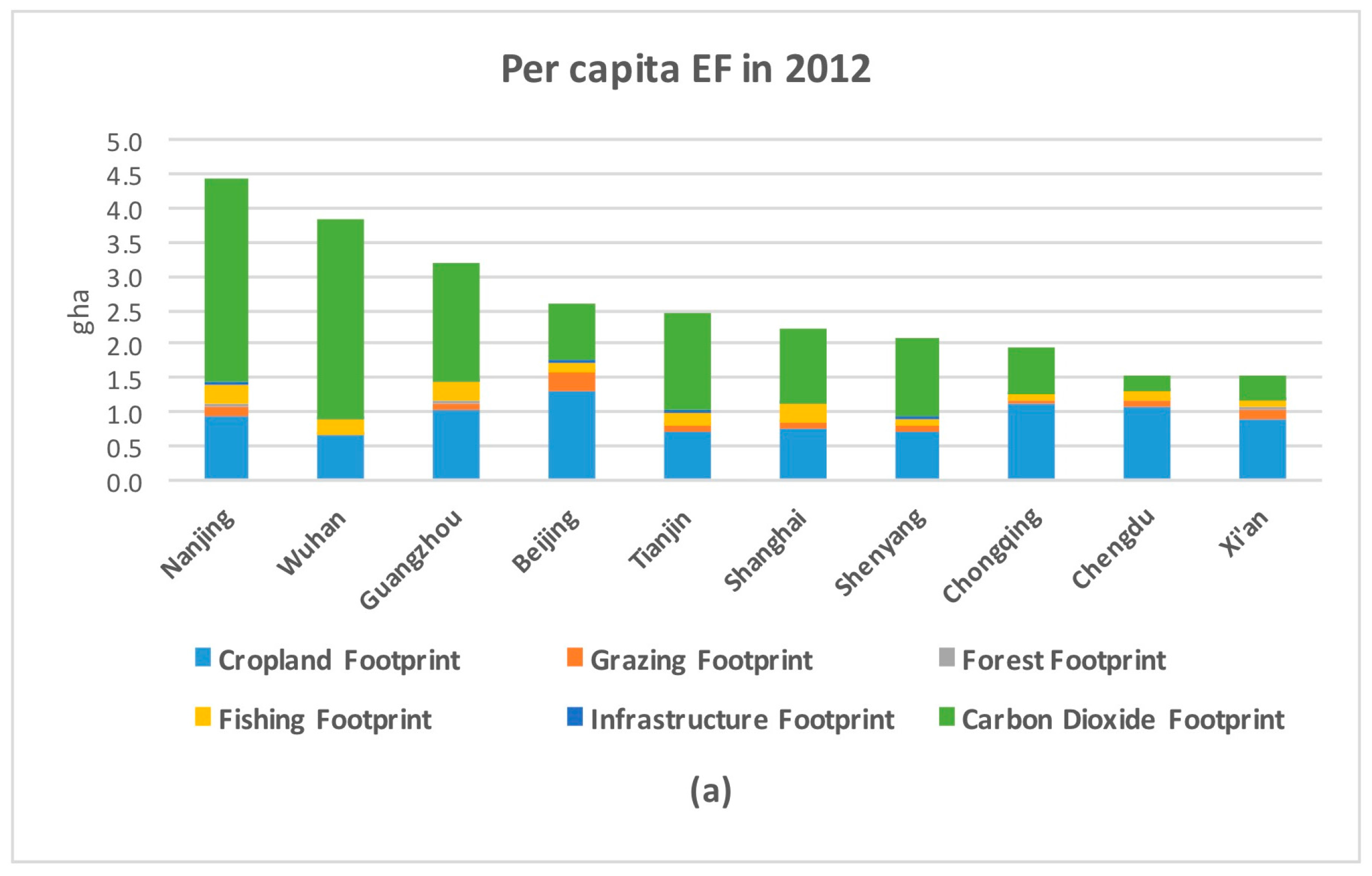
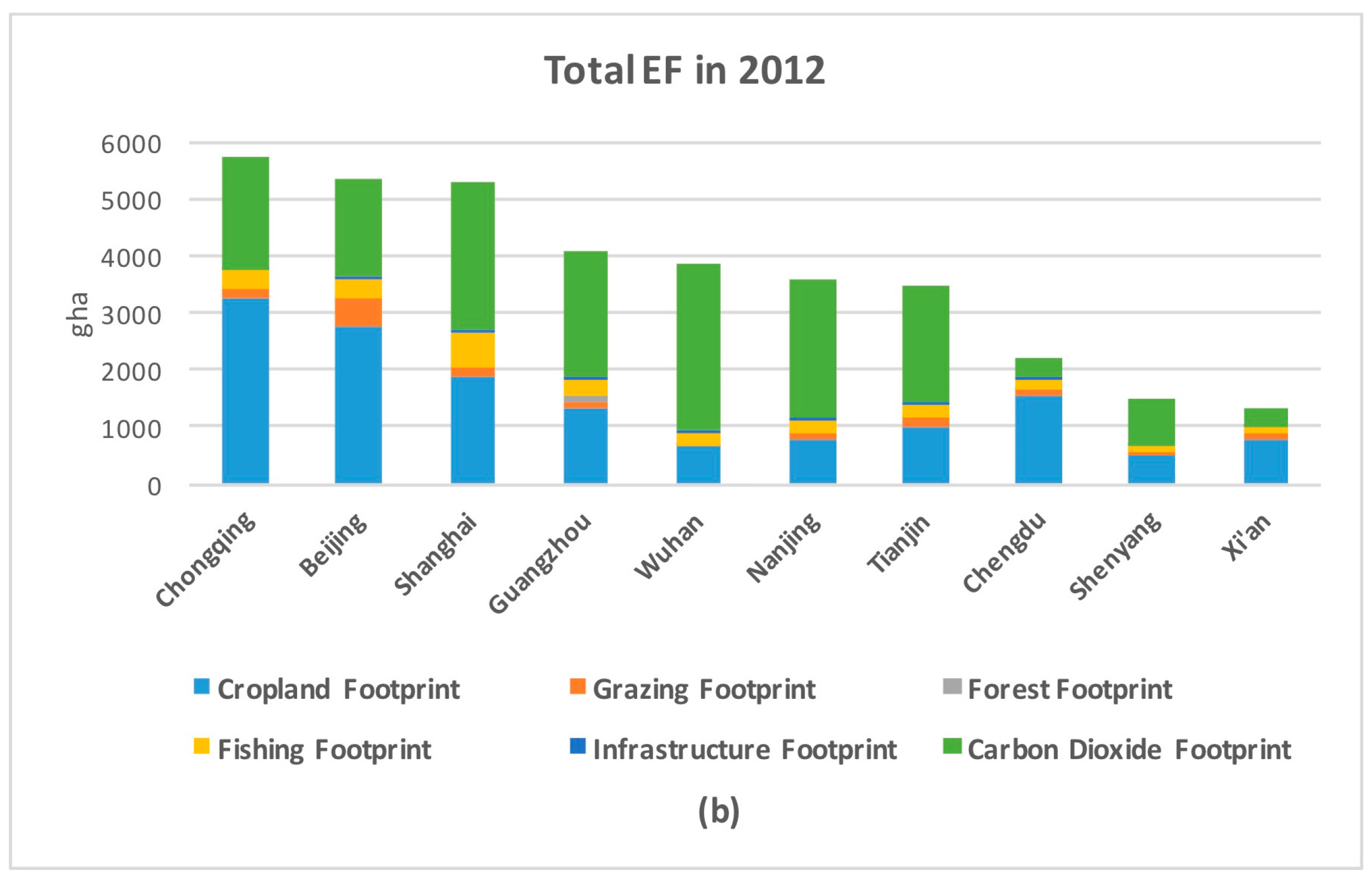

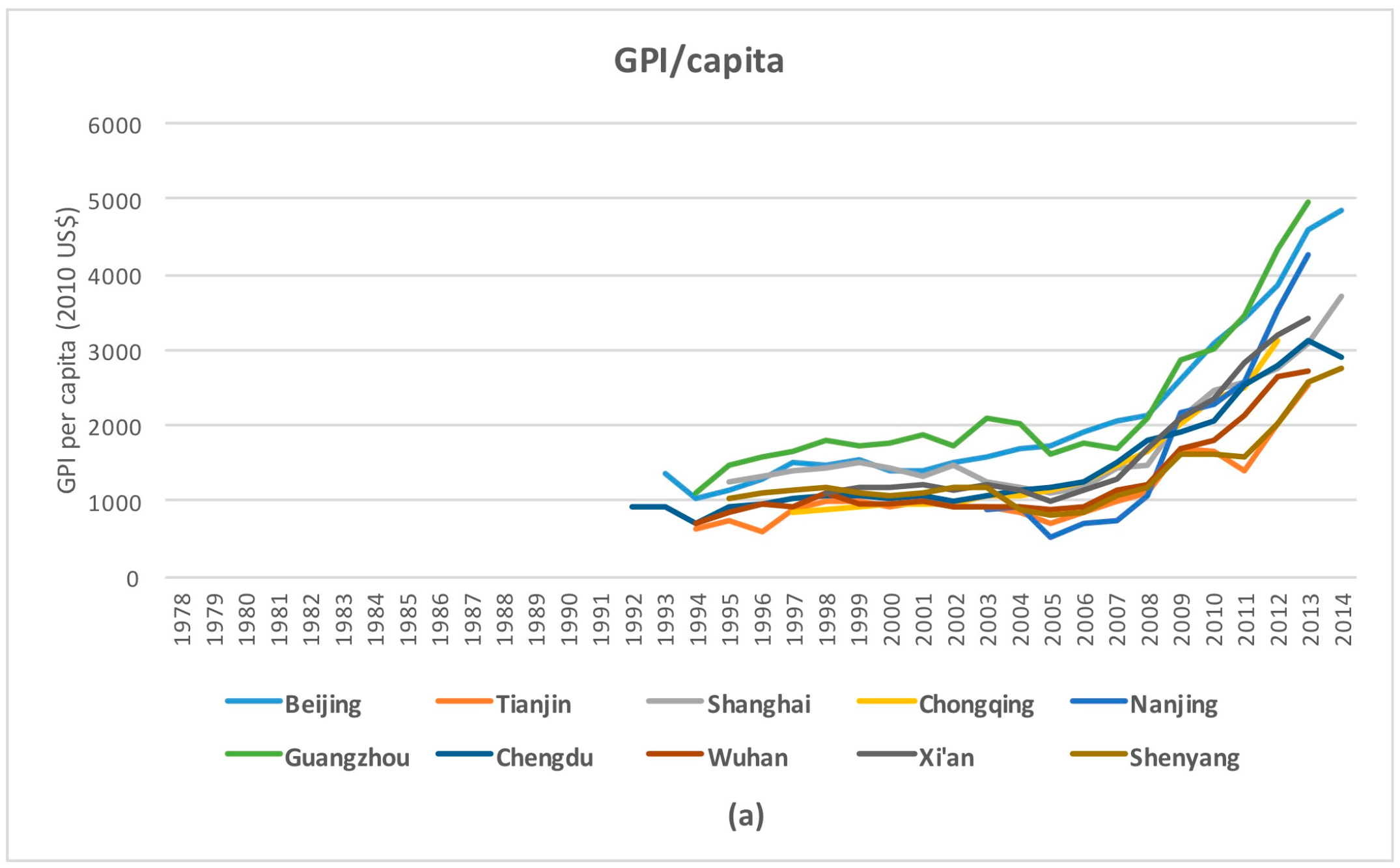

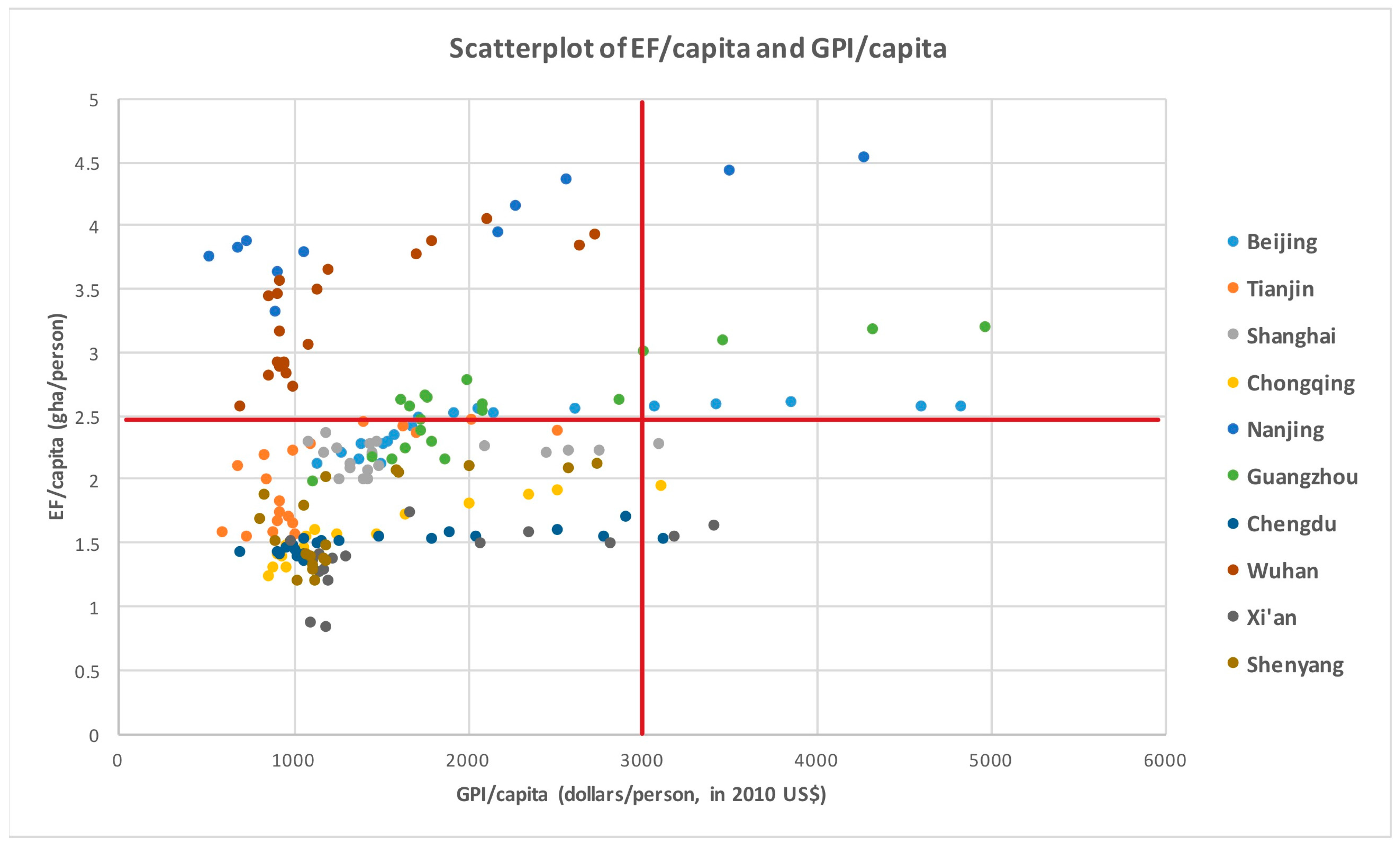
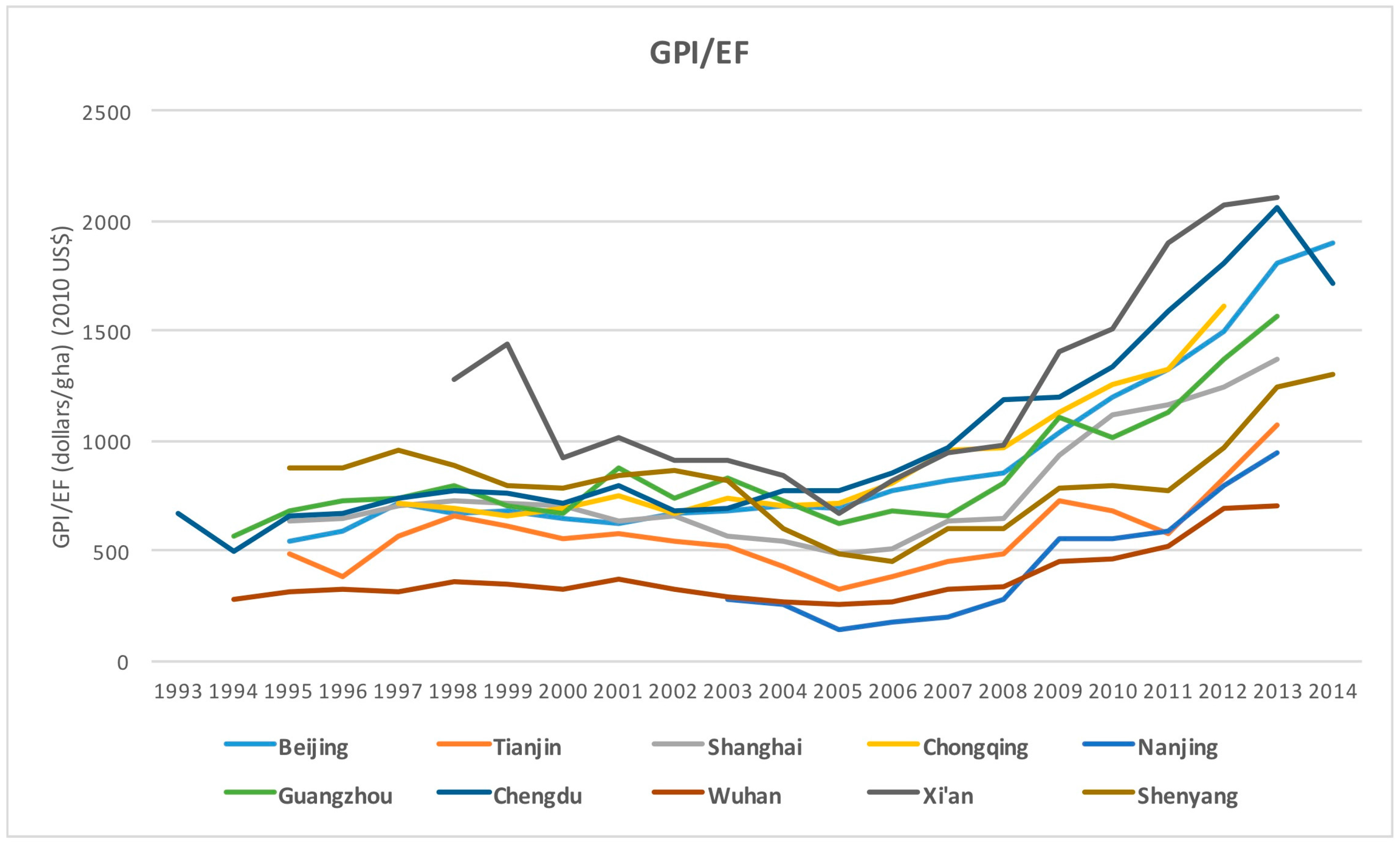
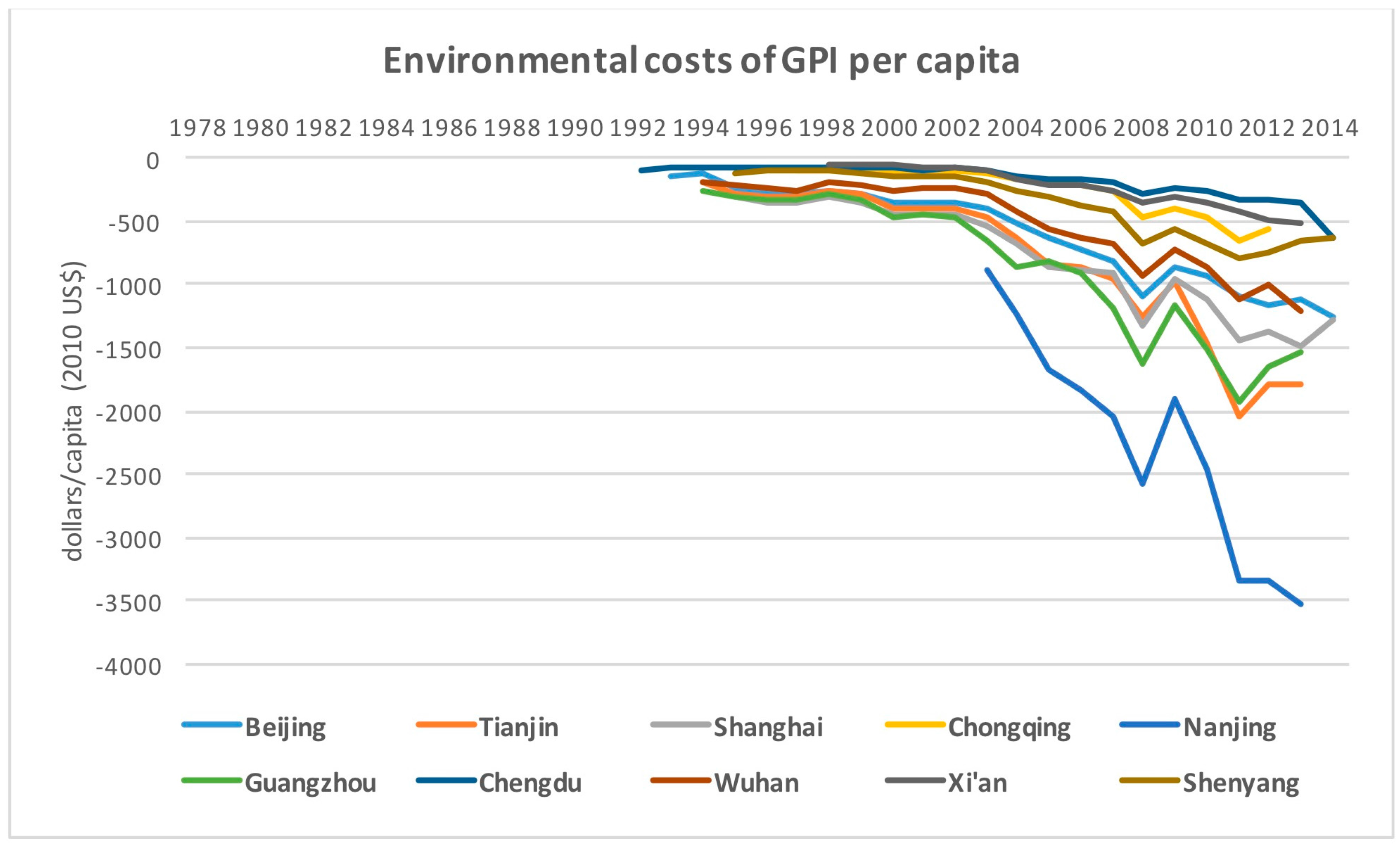
| Region | Megacity | Starting-Ending Year of EF | Starting-Ending Year of GPI |
|---|---|---|---|
| Eastern region | Beijing | 1995–2014 | 1993–2014 |
| Tianjin | 1995–2015 | 1994–2013 | |
| Nanjing | 1993–2013 | 2003–2013 | |
| Shanghai | 1995–2013 | 1995–2014 | |
| Guangzhou | 1992–2013 | 1994–2013 | |
| Western region | Chongqing | 1997–2012 | 1997–2012 |
| Chengdu | 1993–2014 | 1992–2014 | |
| Xi’an | 1997–2013 | 1998–2013 | |
| Middle region | Wuhan | 1990–2013 | 1994–2013 |
| Northeastern region | Shenyang | 1994–2014 | 1995–2014 |
| Unstandardized Coefficients | Standardized Coefficients | t | Significance | ||
|---|---|---|---|---|---|
| B | Std. Error | Beta | |||
| Constant | 0.046 | 0.003 | 13.426 | 0.000 | |
| Carbon Dioxide Footprint | 1.001 | 0.001 | 1.014 | 957.455 | 0.000 |
| Cropland Footprint | 0.966 | 0.004 | 0.266 | 258.096 | 0.000 |
| Fishing Footprint | 0.989 | 0.010 | 0.114 | 99.594 | 0.000 |
| Grazing Footprint | 1.162 | 0.013 | 0.083 | 86.639 | 0.000 |
| Forest Footprint | 1.079 | 0.026 | 0.044 | 41.444 | 0.000 |
| Unstandardized Coefficients | Standardized Coefficients | t | Significance | ||
|---|---|---|---|---|---|
| B | Std. Error | Beta | |||
| Constant | 22.920 | 1.188 | 19.299 | 0.000 | |
| Carbon Dioxide Footprint | 0.999 | 0.001 | 0.578 | 1092.358 | 0.000 |
| Cropland Footprint | 0.995 | 0.001 | 0.569 | 1104.422 | 0.000 |
| Fishing Footprint | 1.032 | 0.006 | 0.106 | 181.290 | 0.000 |
| Grazing Footprint | 1.115 | 0.007 | 0.081 | 161.084 | 0.000 |
| Forest Footprint | 0.898 | 0.023 | 0.017 | 39.139 | 0.000 |
| Beijing | Tianjin | Shanghai | Chongqing | Nanjing | Guangzhou | Chengdu | Wuhan | Xi’an | Shenyang | ||
|---|---|---|---|---|---|---|---|---|---|---|---|
| GPI’s starting point | Consumer expenditure | 4568.7 | 3430.3 | 5583.7 | 2072.0 | 4434.8 | 5761.7 | 2506.5 | 2639.2 | 2873.3 | 3303.0 |
| Economy | Adjustment for unequal income distribution-Rural | 0.0 | 0.0 | 0.0 | 0.0 | ||||||
| Adjustment for unequal income distribution-Urban | −1567.9 | −1380.6 | −2619.1 | −315.6 | 0.0 | −1307.8 | −666.6 | −508.1 | −830.1 | −1137.6 | |
| Cost of consumer durables | −94.8 | −79.5 | −101.9 | −131.0 | −237.3 | −108.5 | −74.4 | −79.9 | −104.3 | −165.2 | |
| Economic costs-Proportion to GPI (%) | −43.0 | −72.0 | −98.7 | −14.3 | −6.8 | −32.7 | −26.6 | −22.2 | −29.3 | −64.6 | |
| Services of consumer durables | 426.5 | 357.9 | 458.7 | 589.4 | 1067.9 | 488.4 | 334.8 | 359.5 | 469.4 | 743.5 | |
| Economic benefits-Proportion to GPI (%) | 11.0 | 17.6 | 16.6 | 18.9 | 30.4 | 11.3 | 12.0 | 13.6 | 14.7 | 36.8 | |
| Society | Cost of crime | −75.2 | 120.7 | −141.5 | −73.1 | −91.5 | −126.2 | −64.9 | −83.5 | −58.2 | −86.2 |
| Cost of automobile accidents | −0.2 | −0.4 | −0.1 | −0.1 | −0.1 | −0.1 | −0.1 | −0.2 | −0.1 | ||
| Cost of commuting | −685.8 | −569.1 | −528.8 | −111.8 | −306.7 | −718.2 | −265.1 | −136.9 | −235.8 | −546.0 | |
| Cost of family breakup | −2.9 | −2.2 | −2.7 | −2.6 | −2.7 | −2.0 | −3.2 | −2.4 | −2.0 | −3.1 | |
| Cost of underemployment | −4.7 | −20.9 | −18.3 | −5.7 | −7.3 | −29.8 | −13.5 | −10.9 | −13.8 | −11.3 | |
| Social costs-Proportion to GPI (%) | −19.9 | −23.3 | −25.1 | −6.2 | −11.6 | −20.2 | −12.4 | −8.8 | −9.7 | −32.0 | |
| Value of leisure time | 2191.9 | 1678.7 | 1266.8 | 1208.7 | 1704.2 | 1791.3 | 1027.5 | 1176.0 | 1286.5 | 346.7 | |
| Value of housework and parenting | 250.2 | 252.7 | 223.9 | 421.3 | 267.9 | 209.5 | 320.4 | 282.6 | 284.7 | 318.2 | |
| Value of volunteer work | 26.7 | 20.4 | 15.4 | 14.7 | 20.7 | 21.8 | 12.5 | 14.3 | 15.7 | 4.2 | |
| Social benefits-Proportion to GPI (%) | 63.8 | 96.2 | 54.6 | 52.8 | 56.7 | 46.7 | 48.8 | 55.6 | 49.7 | 33.2 | |
| Environment | Cost of pollution (air pollution is not included) | −252.3 | −169.9 | −85.9 | −96.7 | −501.1 | −25.3 | −49.2 | −23.9 | −25.2 | −13.2 |
| Cost of air pollution | −250.2 | −264.2 | −245.5 | −112.2 | −256.3 | −305.6 | −166.2 | −229.0 | −147.8 | −232.4 | |
| Cost of wetland loss | 0.0 | −0.4 | −0.1 | 0.0 | −0.1 | 0.0 | 0.0 | −0.1 | 0.1 | 0.0 | |
| Cost of farmland loss | −0.4 | −0.8 | −0.7 | −0.6 | −1.0 | −0.4 | −1.4 | −2.1 | −1.9 | −0.7 | |
| Loss of old-growth forests | 0.0 | 0.0 | 0.0 | 0.0 | 0.0 | 0.0 | 0.0 | 0.0 | 0.0 | 0.0 | |
| Depletion of nonrenewable resources | −632.2 | −1304.3 | −1014.3 | −307.7 | −2517.1 | −1269.7 | −93.7 | −688.2 | −305.1 | −470.8 | |
| Cost of long-term environmental damage | −29.2 | −39.2 | −32.9 | −34.8 | −61.5 | −46.3 | −14.6 | −58.7 | −15.3 | −30.8 | |
| Environmental costs-Proportion to GPI (%) | −30.1 | −87.7 | −50.0 | −17.7 | −95.0 | −38.0 | −11.7 | −37.8 | −15.5 | −37.1 | |
| Results | Resident population (10,000) | 2069.3 | 1413.2 | 2380.4 | 2945.0 | 813.5 | 1283.9 | 1417.8 | 1012.0 | 855.3 | 822.8 |
| GPI/capita | 3868.0 | 2029.3 | 2756.9 | 3114.1 | 3513.0 | 4332.8 | 2788.6 | 2647.5 | 3189.8 | 2018.2 | |
| GDP/capita | 13168.2 | 13905.7 | 12921.1 | 5904.5 | 13491.5 | 16085.9 | 8748.9 | 12053.5 | 7779.9 | 12229.7 | |
| GPI/GDP (%) | 29.4 | 14.6 | 21.3 | 52.7 | 26.0 | 26.9 | 31.9 | 22.0 | 41.0 | 16.5 |
| Unstandardized Coefficients | Standardized Coefficients | t | Significance | ||
|---|---|---|---|---|---|
| B | Std. Error | Beta | |||
| Constant | 3.611 | 0.994 | 3.634 | 0.000 | |
| Cost of crime | 1.001 | 0.004 | 0.057 | 247.309 | 0.000 |
| Services of consumer durables | 0.782 | 0.001 | 0.136 | 576.641 | 0.000 |
| Depletion of nonrenewable resources | 0.998 | 0.001 | 0.385 | 1223.785 | 0.000 |
| Cost of underemployment | 1.000 | 0.040 | 0.007 | 25.071 | 0.000 |
| Consumer expenditure | 1.000 | 0.001 | 1.580 | 1601.695 | 0.000 |
| Adjustment for unequal income distribution-Urban | 1.001 | 0.001 | 0.672 | 1478.015 | 0.000 |
| Cost of commuting | 0.996 | 0.002 | 0.241 | 442.321 | 0.000 |
| Value of housework and parenting | 0.981 | 0.003 | 0.057 | 318.043 | 0.000 |
| Cost of pollution | 1.003 | 0.003 | 0.078 | 329.689 | 0.000 |
| Cost of air pollution | 1.030 | 0.007 | 0.094 | 149.287 | 0.000 |
| Loss of leisure time | 1.012 | 0.001 | 0.629 | 1947.977 | 0.000 |
| Adjustment for unequal income distribution-Rural | 1.042 | 0.015 | 0.010 | 71.826 | 0.000 |
| Cost of long term environmental damage | 0.975 | 0.015 | 0.014 | 65.353 | 0.000 |
© 2018 by the author. Licensee MDPI, Basel, Switzerland. This article is an open access article distributed under the terms and conditions of the Creative Commons Attribution (CC BY) license (http://creativecommons.org/licenses/by/4.0/).
Share and Cite
Huang, L. Exploring the Strengths and Limits of Strong and Weak Sustainability Indicators: A Case Study of the Assessment of China’s Megacities with EF and GPI. Sustainability 2018, 10, 349. https://doi.org/10.3390/su10020349
Huang L. Exploring the Strengths and Limits of Strong and Weak Sustainability Indicators: A Case Study of the Assessment of China’s Megacities with EF and GPI. Sustainability. 2018; 10(2):349. https://doi.org/10.3390/su10020349
Chicago/Turabian StyleHuang, Lu. 2018. "Exploring the Strengths and Limits of Strong and Weak Sustainability Indicators: A Case Study of the Assessment of China’s Megacities with EF and GPI" Sustainability 10, no. 2: 349. https://doi.org/10.3390/su10020349





